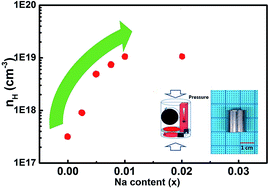The thermoelectric performance of anisotropic SnSe doped with Na†
Abstract
Lead-free polycrystalline SnSe is a promising thermoelectric compound consisting of earth-abundant elements. However, the poor electrical transport property for low intrinsic defect concentration (3 × 1017 cm−3) limits the usage of the stoichiometric SnSe compound. In this work, Na2Se as an acceptor was doped into SnSe in order to optimize the electrical transport properties, especially to increase the carrier concentration. As a result, the carrier concentrations increased and saturated at about 1.0 × 1019 cm−3 for Na0.01Sn0.99Se at 300 K, and a maximum power factor of 0.48 mW m−1 K−2 was obtained. A maximum zT value of 0.75 was obtained at 823 K for Na0.01Sn0.99Se along the direction perpendicular to the sintering pressure, which is 25% higher than that (0.6) of the undoped SnSe compound.


 Please wait while we load your content...
Please wait while we load your content...